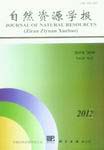Resources Research Methods
XIE Gao-di, ZHANG Chang-shun, ZHANG Lin-bo, SU De, CAO Shu-yan, LENG Yun-fa, XIAO Yu
Three-level zoning system of domain-ecoregion-ecodistrict and top-down division method were adopted, and four domains (i.e., the northeast humid and semi-humid domain, the northern arid and semi-arid domain, the southern humid domain and the Tibet Plateau domain), 11 ecoregions and 63 ecodistricts were identified in China according to quantitative and qualitative indicators (e.g., climate, topography, ecosystem characteristics). Because this scheme pays more attention to the application of the usual name in ecoregion naming, and keeps the integrity of county border, it not only provides scientific basis for protecting, constructing and evaluating national eco-environment, but also makes eco-environmental data better integrated with socio-economic data at county scale, hence leading to more effective ecosystem management, recognizing the position of regional ecological functions and guaranteeing regional eco-security, so as to provide a scientific basis for strategic decision-making, ecological resources conservation, eco-environmental protection and construction at national or regional scale.
